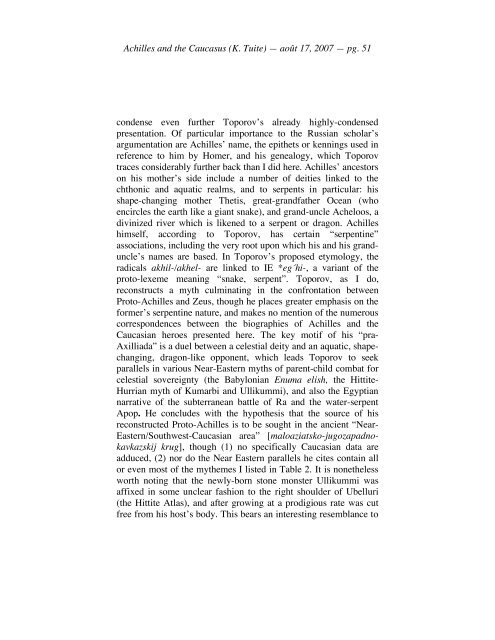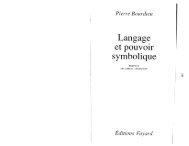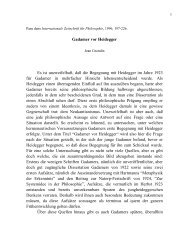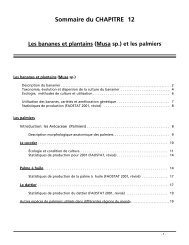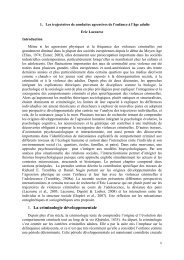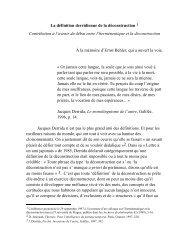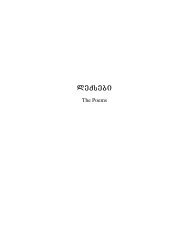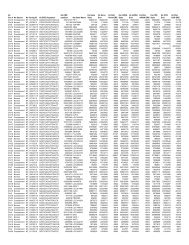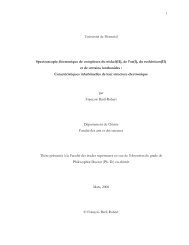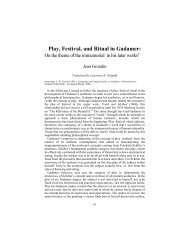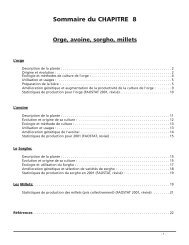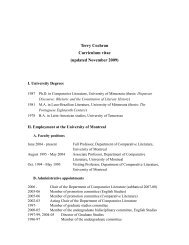Achilles and the Caucasus - Université de Montréal
Achilles and the Caucasus - Université de Montréal
Achilles and the Caucasus - Université de Montréal
You also want an ePaper? Increase the reach of your titles
YUMPU automatically turns print PDFs into web optimized ePapers that Google loves.
<strong>Achilles</strong> <strong>and</strong> <strong>the</strong> <strong>Caucasus</strong> (K. Tuite) — août 17, 2007 — pg. 51<br />
con<strong>de</strong>nse even fur<strong>the</strong>r Toporov’s already highly-con<strong>de</strong>nsed<br />
presentation. Of particular importance to <strong>the</strong> Russian scholar’s<br />
argumentation are <strong>Achilles</strong>’ name, <strong>the</strong> epi<strong>the</strong>ts or kennings used in<br />
reference to him by Homer, <strong>and</strong> his genealogy, which Toporov<br />
traces consi<strong>de</strong>rably fur<strong>the</strong>r back than I did here. <strong>Achilles</strong>’ ancestors<br />
on his mo<strong>the</strong>r’s si<strong>de</strong> inclu<strong>de</strong> a number of <strong>de</strong>ities linked to <strong>the</strong><br />
chthonic <strong>and</strong> aquatic realms, <strong>and</strong> to serpents in particular: his<br />
shape-changing mo<strong>the</strong>r Thetis, great-gr<strong>and</strong>fa<strong>the</strong>r Ocean (who<br />
encircles <strong>the</strong> earth like a giant snake), <strong>and</strong> gr<strong>and</strong>-uncle Acheloos, a<br />
divinized river which is likened to a serpent or dragon. <strong>Achilles</strong><br />
himself, according to Toporov, has certain “serpentine”<br />
associations, including <strong>the</strong> very root upon which his <strong>and</strong> his gr<strong>and</strong>uncle’s<br />
names are based. In Toporov’s proposed etymology, <strong>the</strong><br />
radicals akhil-/akhel- are linked to IE *eg´hi-, a variant of <strong>the</strong><br />
proto-lexeme meaning “snake, serpent”. Toporov, as I do,<br />
reconstructs a myth culminating in <strong>the</strong> confrontation between<br />
Proto-<strong>Achilles</strong> <strong>and</strong> Zeus, though he places greater emphasis on <strong>the</strong><br />
former’s serpentine nature, <strong>and</strong> makes no mention of <strong>the</strong> numerous<br />
correspon<strong>de</strong>nces between <strong>the</strong> biographies of <strong>Achilles</strong> <strong>and</strong> <strong>the</strong><br />
Caucasian heroes presented here. The key motif of his “pra-<br />
Axilliada” is a duel between a celestial <strong>de</strong>ity <strong>and</strong> an aquatic, shapechanging,<br />
dragon-like opponent, which leads Toporov to seek<br />
parallels in various Near-Eastern myths of parent-child combat for<br />
celestial sovereignty (<strong>the</strong> Babylonian Enuma elish, <strong>the</strong> Hittite-<br />
Hurrian myth of Kumarbi <strong>and</strong> Ullikummi), <strong>and</strong> also <strong>the</strong> Egyptian<br />
narrative of <strong>the</strong> subterranean battle of Ra <strong>and</strong> <strong>the</strong> water-serpent<br />
Apop. He conclu<strong>de</strong>s with <strong>the</strong> hypo<strong>the</strong>sis that <strong>the</strong> source of his<br />
reconstructed Proto-<strong>Achilles</strong> is to be sought in <strong>the</strong> ancient “Near-<br />
Eastern/Southwest-Caucasian area” [maloaziatsko-jugozapadnokavkazskij<br />
krug], though (1) no specifically Caucasian data are<br />
adduced, (2) nor do <strong>the</strong> Near Eastern parallels he cites contain all<br />
or even most of <strong>the</strong> my<strong>the</strong>mes I listed in Table 2. It is none<strong>the</strong>less<br />
worth noting that <strong>the</strong> newly-born stone monster Ullikummi was<br />
affixed in some unclear fashion to <strong>the</strong> right shoul<strong>de</strong>r of Ubelluri<br />
(<strong>the</strong> Hittite Atlas), <strong>and</strong> after growing at a prodigious rate was cut<br />
free from his host’s body. This bears an interesting resemblance to


